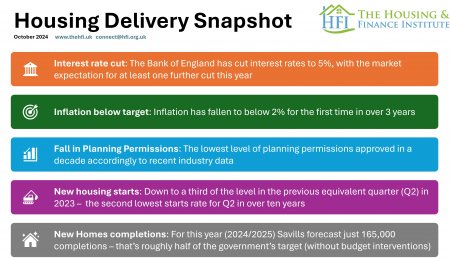

23 MAY 2017
HFi: General Election Special
Since the General Election was called, we're sure you have all been wondering what this means for housing in the UK.
In this General Election newsletter, I set out what the three main political parties are offering in relation to housing. In other words, I've read their manifestos, so you don't have to.
by Matthew Ellery
Programmes Officer at HFi

The Conservative Party's Key Housing Pledges
- Meet their 2015 commitment to deliver a million homes by the end of 2020, and will deliver half a million more by the end of 2022.
- Build 160,000 homes on the government's own land.
- Build new fixed-term social houses, which would be sold privately after 10-15 years, with an automatic Right to Buy for tenants, the proceeds of which, would be recycled into further homes.
- Reform Compulsory Purchase Orders to make them easier and less expensive for councils to use, and to make it easier to determine the true market value of sites.
- Deliver on the reforms proposed in the Housing White Paper.
In the Conservative manifesto, there is a clear focus on not only new, but high quality homes. The policies include both the carrot and the stick approach, with collaboration offered for those building high-quality homes, and the stick for those building at a low-quality.
The HFi welcomes the commitment to helping seaside towns and coastal communities thrive in the manifesto, something the HFi argued for in our Turning the Tide report.
Encouragement is also given to modern forms of construction, and further intervention powers have been promised for councils to ensure planning permission is complied with. As per the Housing White Paper, more land is to be freed up while maintaining strong protections for the green belt.
They have also committed to new Council Housing Deals, and to aid local authorities in building more social housing with significant low-cost capital funding. And with capacity building, such as that provided through our Housing Business Ready municipal muscle programme.
In summary, there is a strong emphasis on building more homes, council leadership and ensuring homes are of a better quality.

The Labour Party's Key Housing Pledges
- Build one million new homes.
- Build at least 100,000 council and housing association homes a year for 'genuinely' affordable rent or sale by the end of the next Parliament.
- Guarantee Help to Buy funding until 2027.
- Introduce an inflation cap on rent rises.
- Suspend the Right to Buy policy, with councils only able to resume sales if they have a plan to replace homes sold on a like-for-like basis.
There is a clear emphasis from Labour in their manifesto that they want to improve the consumer's lot when it comes to housing, especially in relation to social housing.
As with the Conservatives, there is a pledge to build a significant number of new homes. But, they have also committed to creating a new 'Department for Housing' to improve the number, standards and affordability of homes. In addition, Labour wants to overhaul the Homes and Communities Agency to focus solely on active market delivery.
Brownfield sites would be prioritised to protect the green belt. And councils would be given more powers and investment to build more homes through a new 'National Transformation Fund'.
Modern standards on minimum space and 'zero carbon homes' would be introduced after consultation. And local residents would get 'first dibs' on any new homes. Protections would be extended for leaseholders against ground rents, while introducing an inflation cap on rent rises.
The ban on long term council tenancies would be removed, while the Right to Buy scheme would be curtailed.
In summary, council housing will be prioritised in the housebuilding programme, and ensuring everyone – whether their homes are in the public or private sector – is guaranteed minimum rights and standards.

The Liberal Democrats' Key Housing Pledges
- Build 300,000 'sustainably planned' homes a year, with a government commissioning programme directly building homes to fill the gap left by the market.
- Build half a million affordable and energy-efficient homes by the end of the next Parliament.
- Introduce a new 'Rent to Own' model, where rent payments would give tenants an increasing stake in the property, owning it outright after 30 years.
- Establish a new 'Help to Rent' scheme, to provide government-backed tenancy deposit loans for all first-time renters under 30.
- Lift the borrowing cap on local authorities, and increase the borrowing capacity of housing associations.
The Liberal Democrats' manifesto focuses heavily on giving further powers to local councils and innovative suggestions around forms of ownership.
Once again, a large housebuilding programme is proposed, with the Liberals having the most optimistic target of 300,000 homes a year, along with ten new garden cities. However, there is an added emphasis on sustainability and the environment. This target would be reached due to a government commissioning programme directly building homes to fill the gap left by the market.
A new government-backed British Housing and Infrastructure Development Bank would be set up. Its remit would include providing long-term capital for major new settlements and helping attract finance for major housebuilding projects.
The borrowing cap on local authorities would be lifted, and the borrowing capacity of housing associations would be increased. They would also pass further powers to local authorities, such as giving them the ability to double council tax on second homes and penalise land banking, among other suggestions.
More innovatively, they have also proposed new 'Rent to Own' and 'Help to Rent' schemes.
In summary, the Liberal Democrats have provided something innovative and different, while simultaneously pledging to build more homes and devolve further powers to local councils.
March 2025 Housing Delivery Snapshot

January 2025 Housing Delivery Snapshot

December 2024


